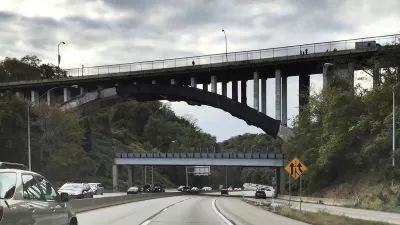The Kentucky Transportation Cabinet is having a difficult time explaining to the public how the 122-year-old bridge can be safe for motorized vehicles "up to nine tons" but pedestrians pose a weight problem.
It's known as the 'singing' bridge due to the hum made by vehicles crossing it. But folks in Frankfort, the state capital, haven't been singing since the Kentucky Transportation Cabinet (KYTC) closed the sidewalk.
"David Steele, the branch manager for Bridge Preservation with Kentucky Transportation Cabinet (KYTC), said it was late on Thursday that an engineer consulting firm informed KYTC that the trusses on the 122 year old bridge had deterioration," writes WLEX TV. "They said the deterioration reduced the structural capacity, meaning the bridge could fail with too much weight."
"The bridge is not unsafe, it's perfectly fine for vehicular traffic as long as they abide by the current 9 ton posted weight limit," said David Steele, the branch manager for Bridge Preservation with KYTC. "We cannot have both vehicular traffic on the bridge and pedestrian."
However, it's clear from the article and the attached news video that walkers don't buy the pedestrian prohibition, nor even motorists for that matter.
"I guess, it's a little confusing," said Hannah Davis. She works nearby at the White Light Diner. "That's the scary part I think. I mean, I don't know if I want to drive over it if it can't hold an extra 200 pounds."
"KYTC says one or two people aren't the problem, but 20 or 30 at a time could be an issue," adds WLEX. "They said they have no way to regulate how many people walk on the bridge at a time."
I did a little math. Thirty people, each weighing 175 pounds, amounts to 2.6 tons, yet there is no restriction on how many 9 ton vehicles that can cross the bridge?
This is not the first time that KYTC planners and engineers have collided with the public. Last year they took on the city's tree advocates to prevent new shade trees from being planted along streets.
Hat tip to AASHTO Daily Transportation Update for their "Pedestrians/Bicycles" section.
FULL STORY: "Singing Bridge" Closed To Pedestrians, Not Vehicles

Planetizen Federal Action Tracker
A weekly monitor of how Trump’s orders and actions are impacting planners and planning in America.

Maui's Vacation Rental Debate Turns Ugly
Verbal attacks, misinformation campaigns and fistfights plague a high-stakes debate to convert thousands of vacation rentals into long-term housing.

Restaurant Patios Were a Pandemic Win — Why Were They so Hard to Keep?
Social distancing requirements and changes in travel patterns prompted cities to pilot new uses for street and sidewalk space. Then it got complicated.

Charlottesville Temporarily Has No Zoning Code
A judge ordered the Virginia city to throw out its newly revised zoning code, leaving permitting for new development in legal limbo.

In California Battle of Housing vs. Environment, Housing Just Won
A new state law significantly limits the power of CEQA, an environmental review law that served as a powerful tool for blocking new development.

Boulder Eliminates Parking Minimums Citywide
Officials estimate the cost of building a single underground parking space at up to $100,000.
Urban Design for Planners 1: Software Tools
This six-course series explores essential urban design concepts using open source software and equips planners with the tools they need to participate fully in the urban design process.
Planning for Universal Design
Learn the tools for implementing Universal Design in planning regulations.
Heyer Gruel & Associates PA
JM Goldson LLC
Custer County Colorado
City of Camden Redevelopment Agency
City of Astoria
Transportation Research & Education Center (TREC) at Portland State University
Jefferson Parish Government
Camden Redevelopment Agency
City of Claremont




























